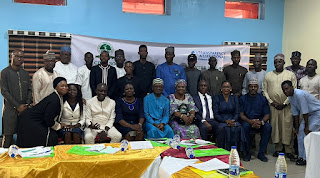Female Genital Mutilation: Time To End Cruelty Against Womanhood
Chioma Umeha
As Nigeria joins in the celebration of
International Day for Zero Tolerance Against Female Genital Mutilation (FGM)
today, CHIOMA UMEHA writes that the country which shares 25 per cent of the
burden of FGM which occurs in Africa is home to millions of girls and women who
have undergone FGM, a dehumanising practice which endangers their life.
Like every young lady who is ripe for marriage,
Chinwe Ude was happy to tie the nuptial knots at the age of 24. But, her joy
was cut short by dyspareunia – pain during sexual intercourse. The diagnosis of
Chinwe’s condition was linked to FGM.
Also, Funmi Adigun, 23, suddenly began to
experience vagina itching, painful urination and menstrual problems, shortly
after marriage. She was further diagnosed with genital tissue and reproductive
tract damage as a result of FGM which was performed on her at the age of five.
For Miriam Abubakar, her joy knew no bounds when
she got married at the age of 33. Hardly had she completed her honeymoon when
she started having vagina itching and painful urination. Next, she began to experience menstrual
problems. Miriam was later diagnosed of chronic genital infections and cyst.
Subsequently, her new marriage was threatened.
Miriam’s joy when she later became pregnant was short-lived as she was a victim
of prolonged labour, post-partum haemorrhage and still birth.
Her doctor had performed surgery on her to correct
the damage done to her female genitalia after she was infibulated as a child
before the pregnancy occurred. Her genitalia had to be opened for the passage
of penis and baby.
Also, her female genitalia were further cut open
to allow passage of foetal head while she remained in serious pains.
Her parents had ignorantly allowed her genitals to
be cut when she was age one, because they reportedly wanted to prevent her from
being promiscuous. They wanted her virginity to be preserved so that her bride
price would be huge.
“I married my heartthrob after searching patiently
for a husband; today I cannot enjoy my marriage. I blame my parents for
everything. If my parents had not insisted on tradition, my marriage would not
have crashed,” Miriam tearfully told DAILY INDEPENDENT.
Chinwe, Funmi and Miriam represent millions of
girls who go through torture under the knives of genital mutilators worldwide.
What the three women underwent was Type 3 FGM,
which is called Infibulation. That is the removal of all external genitalia,
which leave a small opening for blood and urine.
This procedure is usually performed by elderly
women using scissors, razor blade or knives under unsanitary conditions and no
anaesthetics used.
The World Health Organisation (WHO) reports that
Female genital mutilation includes all procedures which involve partial or
total removal of the external female genitalia or injury to the female genital
organs, whether for cultural or any other non-therapeutic reasons.
The world health body further classifies FGM into
four major types, namely; Type I (Clitoridectomy), Type II (Excision), Type III
(Infibulation) and Type IV.
Commenting, Olutayo Aderonke, UNICEF FGM
Consultant, Ekiti, Osun and Oyo, noted that the health implication of FGM
ranges from excessive bleeding, pain, shock, genital tissue swelling,
infections, pro-longed labour, Caesarean Section and postpartum haemorrhage are
some of the risks of Female Genital Mutilation.
Aderonke spoke at a recent two-day review meeting
with ‘Media – Radio – Partners on Ending FGM in Nigeria,’ which was organised
by National Orientation Agency (NOA), Oyo State with support from UNICEF.
The United Nations (UN) health body in 2018
reported that young girls between zero and 15 years, even women are subjected
to female genital mutilation in worldwide.
“Of the 200 million girls and women globally
living with the consequences of FGM, 44 million are aged less than 15 years,”
the report further said.
According to the report, three million girls are
at risk of the practice every year, with Nigeria being among the four countries
where two thirds of all women who have undergone FGM live; the other three
countries are Egypt, Ethiopia, and Sudan.
Specifically, Nigeria shares 25 per cent of the
burden of female genital mutilation which occurs in Africa.
Analysts are therefore worried over the high level
of ignorance concerning the practice of FGM among Nigerians.
Most recent estimates from ‘UNFPA-UNICEF Joint
Programme On FGM Abandonment: Accelerating Change Phase II report from 2014 to
2017,’ shows that Nigeria has zero to 28 per cent prevalence of FGM practice
alongside Yemen.
In 2016, UNICEF estimated that at least 200
million women and girls in 30 countries have been subjected to FGM.
Concerning the practice in Nigeria, Aderonke said,
despite being known to be widespread in the country and important in
international discourse. She also said that national data on FGM’s prevalence
in the country is comparatively rare.
She explained that earlier focus in the country
has generally been on three major types of FGM, including; Type I, Type II, and
Type III.
However, she added that recent evidence shows that
different forms of Type IV are as prevalent as the other three types,
especially in the northern region, where little attention has been paid over
the years. Type IV comprises a variety of practices that do not involve removal
of tissue from the genitals.
The UNICEF FGM Consultant further observed that
the FGM procedure can take place anytime from a few days after a child’s birth
to a few days after a woman’s death in many parts of Nigeria.
Corroborating, Benjamin Mbakwem, also FGM Consultant
for Ebonyi and Imo States, UNICEF Enugu
Field Office, said it is an outdated practice and tradition that is threatening
the rights of girls and women to development, protection and ultimately,
survival.
Mbakwem stressed that no form of female genital
mutilation is safe as it endangers women’s life.
Describing the structure of the normal female
external genitalia, he said this includes: Skenes and Bartholin’s glands,
vaginal orifice, urinary meatus, clitoris, perineum, labia minora and labia
majora.
According to him, the functions of the normal
female external genitalia are: lubrication of the vagina, allowing the escape
of the menstrual flow, sexual intercourse and delivery of the baby.
He further said, it allows emptying of the bladder
within a few minutes, it assists women to achieve sexual satisfaction, supports
the pelvic organs, separates the vagina from the anus, protects structures and
orifices and protects the inner structures and orifices.
The unaltered female genitalia are the prepuce,
labia minora, labia majora, Bartholin glands, clitoris, urethra, vaginal
introitus, perineum and anus, adding that any form of FGM affecting the female
external genitalia has grave implications.
He explained that female genital mutilation is
classified into four types including, Clitoridectomy which is the partial or
total removal of the clitoris (a small, sensitive and erectile part of the
female genitals) and in very rare cases, only the Prepuce (the fold of the skin
surrounding the clitoris).
Under the first type of the female genital
mutilation, he said, there are two other parts which is the removal of the
prepuce/ clitoral hood (circumcision ) and the removal of the clitoris with the
prepuce (clitoridectomy).
The second type is excision which is the partial
or total removal of the clitoris and the labia minora, with or without excision
of the Majora – the labia are ‘the lips’
that surround the vagina.
The last type, he added, is the Infibulation which
is the narrowing of the vaginal opening through the creation of a covering
seal. The seal is formed by cutting and repositioning the inner, or outer,
labia, with or without removal of the clitoris.
According to him, the final type is the
unclassified which is the use of all other harmful procedures to the female
genitalia for non-medical purposes, for example; pricking, pulling, piercing,
incising, scrapping and cauterization.
However, he faulted the practice, noting, “This is
an unbridled contravention of the international Child Rights Act adopted by
Nigeria in 2003 to domesticate the convention on the Rights of the child.
“Despite the fact that some States have passed it
into law, it is still a daunting task fighting FGM in the Southwest,” Mbakwem
insisted.
According to WHO, the practice of FGM enables the
victims to be automatically open to various risks which may be immediate, long
term, psychological, sexual functioning, or obstetric.
The immediate risks the victims are exposed to
include: excessive bleeding, pain, shock, genital tissue swelling, infections,
wound healing problems, as well as death, the UN health body reports.
Contributing, Dr. Olasunbo Odebode, Child
Protection Specialist, UNICEF, Abuja, noted that the victims are further
exposed to long term risks which may include: genital tissue damage, vaginal
discharge and itching, menstrual problems, chronic genital infections,
reproductive tract infections, urinary tract infections, keloids and cyst.
Bemoaning the tragic consequences of FGM on
victims, she said, they are at risk of childbirth complications including;
prolonged labour, post-partum haemorrhage, still birth, early neonatal death,
caesarean section, extended maternal stay and episiotomy among other factors.
Apart from the physical risks the victims are
exposed to, they can also be affected psychologically. Dr Odebode said,
“Victims can be depressed, have anxiety disorder, or post-traumatic stress
disorder (PTSD).”




Comments
Post a Comment